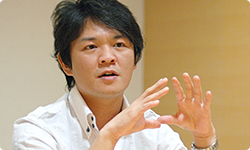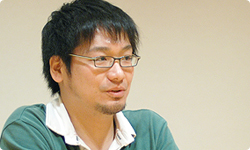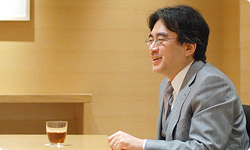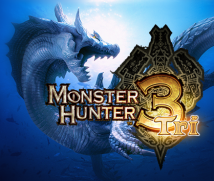4. Staring at the Wii Remote
In a lot of different ways I can sense the spirit of “not wanting to lose” that Fujioka-san spoke of.
The first project planning document that we wrote said, “Let’s make the best graphics ever seen on the Wii console!” Such statements could be found throughout that document with regard to other areas as well. It was clear there was a great deal of determination among the developers. Then Nintendo let us show a video trailer at the Nintendo exhibition.
You mean the 2007 Nintendo Conference3. 3Nintendo Conference Autumn 2007: A presentation held at Makuhari Messe in Japan in October 2007 for the mass media, distributors and others involved with the video game industry. On stage, a game trailer from Monster Hunter Tri was shown and demonstrations of Wii Fit were also performed.
Right. At that time, we were able to show visuals using an actual Wii, and I was certain we would be successful. After that, all I had to do was tell the development staff to continue creating visuals of such a high standard for the game. (laughs)
(laughs) Actually, even after the Nintendo Conference, we clashed with the designers several times. Since we had already released it, there was no way we could do something completely different from the trailer. The designers had always had that certain vision, so the visuals never foundered.
You set the bar high right at the start, and then tried to aspire to it.
That’s why I think we were able to work from start to finish without changing that much.

Perhaps you could do that much more fully than a normal director because, based on your extensive experience - including your time creating pixel art - you were able to tell others; “When you do something here, something else needs to be sacrificed.”
I suppose so. I am always showing off how I used to be a designer. (laughs)
That way they can’t pull the wool over your eyes.
Yeah! You can’t fool me! (laughs) And I have the right to tell them they can do more.
I often do that myself with regard to programming. (laughs)
(laugh)
So if they say, “We can’t do any more,” I say, “Well, if you cut back here you should be able to.” That’s how we proceeded with our work, and that gave birth to a positive tension among the designers. The result was something we could all accept.
Looking at the graphics objectively, I feel like the game’s visuals are one of the representative examples of what can ultimately be done with Wii.
Thank you very much.
I think it has placed the Zelda team under a considerable amount of pressure. (laughs)
I doubt that! (laughs)
Our work is spurring each other to new heights.
Yes. Since we were able to create something good, the development team has grown quite confident.

So, while you were satisfied with the visuals, were you at a bit of a loss when you first saw the Wii Remote as to how it could be used for Monster Hunter?
(laughs) Well, I’m the type who gets really excited when he sees a completely new kind of device. I was like that when the Nintendo DS and Wii were announced. I knew I was going to be able to create gameplay in an entirely new way and I thought that was great. Objectively speaking.
Objectively. (laughs)
Yeah. Objectively. (laughs) But then when I tried it out, I was like, “Hmm.” (laughs) To put it without choosing my words too carefully...
Please, be honest. (laughs)
Well, first of all, the buttons...
There weren’t enough? (laughs)
Monster Hunter was originally made so you used all of the many buttons on the controller. So when we decided to make Monster Hunter Tri for Wii, I just sat and stared at the Wii Remote for a long time.
Even before we had anything to put on the screen, Fujioka was holding the controller and thinking about it day and night.
You couldn’t figure out how to make Monster Hunter for the button-light Wii Remote?

When we announced at the Nintendo Conference that Tri would be for Wii, people kept asking if they would have to swing the Wii Remote.
Co-workers were asking me about it, too. “You’re releasing it for Wii, right? What are the controls going to be like?” (laughs)
They were worried it might not work out all right with the Wii Remote? (laughs)
They kept asking, “So we’re gonna have to swing the Wii Remote?”
But from the very beginning we weren’t thinking about swinging the Wii Remote to hunt. We wanted a method of game operation that wouldn’t be tiring.
Because it’s a game that some people will play for very long periods.
So we decided to view the Wii Remote and Nunchuk as one controller, without thinking about the motion sensor. We started by asking how the game should be operated. How should the buttons function in order for the game to feel good and be fun?
The unique methods of game control in the Monster Hunter series have always been a challenge.
They require fairly complicated use of your fingers - like pushing the stick slightly to one side while pushing a certain button.
Right. But it’s also a game we’ve always wanted to be simple to play, so this time we started all over from zero with regard to game operation as well.
Which brings us back to what we were saying earlier about starting at ground level.
That’s right. We tried to distance ourselves from the habit of thinking that a certain thing was tied to certain buttons. When we considered how to play Monster Hunter with the Wii Remote and Nunchuk, we thoroughly and repeatedly thought about what would physically feel right.
